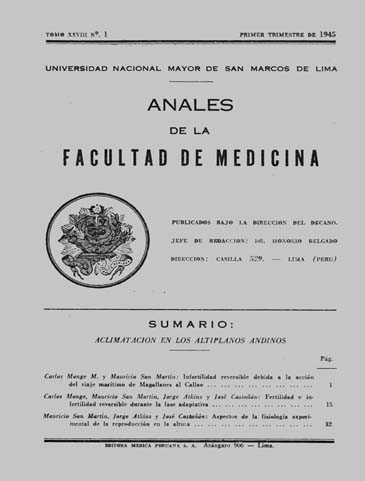Acclimation of sheep at high altitude
DOI:
https://doi.org/10.15381/anales.v28i1.9641Abstract
Until 1940, the prevailing view regarding the declining birth of sheep in the highlands compared to what is obtained at sea level, was based on the belief in the existence of sheep "butch" unable to reproduce. Despite this, farmers employing 5 or 7 acclimated males per 100 sheep, long residence with blood from sheep brought for the Colony; while at sea level, this percentage never exceeded 2 or 3 Yet it was extremely difficult to obtain, with imported animals, a higher reproduction ratio to 30% or 40%, particularly the first year of acclimatization, during which the percentage of fertility fell within 20% with the consequent economic loss.Downloads
Published
1945-03-19
Issue
Section
Trabajos originales
License
Copyright (c) 1945 Carlos Monge M., Mauricio San Martín, Jorge Atkins, José Castañón

This work is licensed under a Creative Commons Attribution-NonCommercial-ShareAlike 4.0 International License.
Those authors who have publications with this magazine accept the following terms:
- Authors will retain their copyrights and guarantee the journal the right of first publication of their work, which will be simultaneously subject to Creative Commons Attribution License that allows third parties to share the work as long as its author and its first publication this magazine are indicated.
- Authors may adopt other non-exclusive licensing agreements for the distribution of the version of the published work (eg, deposit it in an institutional electronic file or publish it in a monographic volume) provided that the initial publication in this magazine is indicated.
- Authors are allowed and recommended to disseminate their work over the Internet (eg: in institutional telematic archives or on their website) before and during the submission process, which It can produce interesting exchanges and increase quotes from the published work. (See El efecto del acceso abierto ).
How to Cite
1.
Monge M. C, San Martín M, Atkins J, Castañón J. Acclimation of sheep at high altitude. An Fac med [Internet]. 1945 Mar. 19 [cited 2025 May 23];28(1):15-31. Available from: https://revistasinvestigacion.unmsm.edu.pe/index.php/anales/article/view/9641



